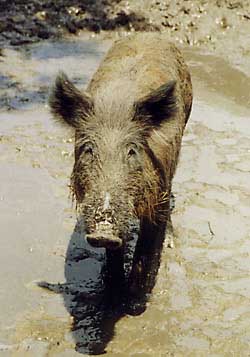Feral pigs are very intelligent animals and readily adapt to changing conditions. These wild pigs may modify their response to humans fairly rapidly if it benefits their survival. Wild boar (introduced from Europe) have a greater capacity to invade colder and more mountainous terrain than do other feral pigs. Feral hogs feed during daylight hours or at night, but if hunting pressure becomes too great during the day, they will remain in heavy cover at that time and feed at night. In periods of hot weather, wild pigs remain in the shade in wallows during the day and feed at night.
Hands down, the feral pig is the most prolific large wild mammal in North America. Given adequate nutrition, a wild pig population can double in only 4 months. Feral hogs may begin to breed before 6 months of age, if they have a high-quality diet. Sows can produce 2 litters per year and young may be born at any time of the year. Wild boar usually do not breed until 18 months of age and commonly have only 1 litter per year unless forage conditions are excellent. Like domestic animals, the litter size depends upon the sow’s age, nutritional intake, and the time of year. Litter sizes of feral hogs in northern California average 5 to 6 per sow. Wild boar usually have litter sizes of 4 to 5 but may have as many as 13.
